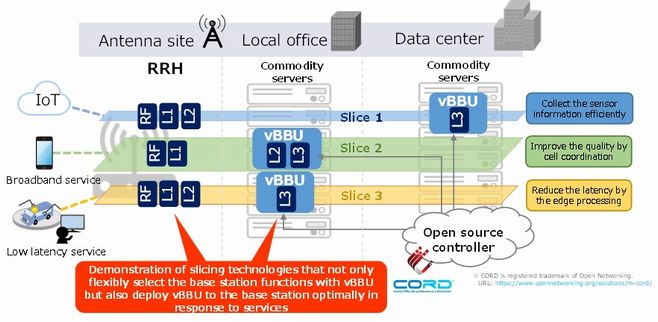 Print
Print
Slicing technology developments for virtualized 5G base station
- The world's first successful demonstration of next-generation technology for building an on-demand optimal network -
May 21, 2018
KDDI Research, Inc.
Saitama, Japan, may 21, 2018 -- KDDI Research, Inc. announced today that it has developed a slicing technology (*1) to operate in a base station that is using virtualization technologies. For the first time in the world (*2), we succeeded, using prototype equipment, in demonstrating next-generation technologies to build an optimal network responding to service demands. This ensures the rapid deployment of services and operational flexibility designed to meet the needs of our customers in order to deliver a high quality and stable network to realize the wide range of services including massive IoT, ultra-high speed and ultra-low latency that are expected in 5G, the next generation mobile communication system. We will show these results at the KDDI booth at WTP2018 (Wireless Technology Park 2018), to be held at Tokyo Big Sight (Koto-ku, Tokyo) from May 23 (Wed) to May 25 (Fri).

Figure 1 Diagrammatic view of slicing technology for a virtualized base station
[Background of the Development]
To provide a 5G system, a wide variety of services with different quality requirements are being explored, such as massive IoT services that collect information from large-scale sensor information terminals, ultra-high-speed communications that transmit Ultra High Definition video – 4K/8K, and ultra-low-latency services for remote control in factories. Therefore, to meet the different quality requirements of these various services, the technologies for software control of virtualized base station functions (*3) are being discussed. The organization that manages the 5G standards, 3GPP (The Third Generation Partnership Project), reviews the base station functions to be deployed on the antenna site and the station in conjunction with virtualization. It was not demonstrated to have multiple slice technologies for the base station to be able to respond to the various quality requirements of each service.
[The Results]
KDDI Research has developed base station slicing technologies that not only maximize the benefits of virtualization and flexibly select the base station functions with vBBU (*4), but also deploy vBBU to the base station optimally in response to services. In addition, we developed a prototype device using open source software (*5) in cooperation with Cavium (NASDAQ: CAVM) (headquartered in San Jose, California, USA, CEO: Syed Ali) and succeeded in demonstrating the next generation technology to build the optimal network in response to services’ requirements (Figure 2).
The demonstration used two types of slicing technologies, sensor device communication for IoT service (slice 1) and video streaming transmission (slice 2) for a broadband service. It verified the feasibility while ensuring that they can operate without interfering with each other between the slices.
The deployment location of the vBBU is strongly related to the network performance including the amount of delay given to the application and capacity of the number of terminals. With this optimization, it will help you to respond to the demand quality of the range of services that are expected in the "5G" era. In addition, since the slice can be set up or changed easily under software control, it enables the design and rapid deployment of new services or operational flexibility tailored to customer needs in order to provide a high-quality and stable network.

Figure 2. Overview of the slicing technologies of virtualized base stations
[Future Prospects]
KDDI Research will expand the newly developed prototype equipment to strengthen the features that enable the automatic deployment and selection of base station functions in response to services, and we also will promote research and development and standardization for practical use of the prototype equipment.
[Terminology]
*1: Slicing technology: Logically dividing the network according to the service
*2: Studied at KDDI Research for the first time in the world, KDDI Research proposed the concept of virtualized base station slicing technology and demonstrated it using the prototype device.
*3: Base station features: Base station consists of BBU (Baseband Unit), wireless control devices, and RRH (Remote Radio Head), wireless receiving device. The entire base station implements a range of features (RF, Layer 1 to 3) such as signal processing, retransmission control, radio link control, and packet processing.
*4: vBBU: virtualized Baseband Unit
*5: M-CORD: Mobile-Central Office Re-architected as a Datacenter,
[Trademark]
CORD is a registered trademark of the Open Networking Foundation.
【About KDDI Research】
KDDI Research plays the core of research, development and think tank of KDDI group. Looking to the future beyond 2020, KDDI Research would like to strengthen and accelerate the creation of next-generation technologies and the enhancement of the ability to predict the future across the company, while promoting a seamless flow from research analysis to R&D. In order to provide customers with new value and experiences, we would like to continue the “Challenge for the Future” through such activities.
※The information contained in the articles is current at the time of publication.Products, service fees, service content and specifications, contact information, and other details are subject to change without notice.